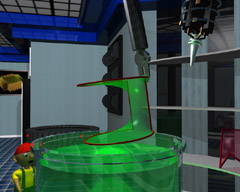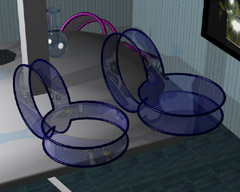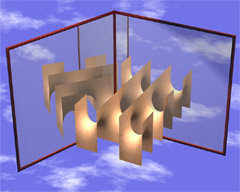|
|
Touching Soap Films |
|
|
|
Scenes from the Video IIMinimality Property
The original characterization of minimal surfaces as objects with minimal surface area is visualized on different occasions. Plateau's Magic Surface in the central hall of the palace demonstrates soap films with varying boundary contours and gives a glimpse of the possible shapes. In the laboratory sequence the professor explains the minimality properties using a rubber band as a one-dimensional analogue: the rubber band is spanned between two points and contracts to a curve with minimal length under the tension of the rubber molecules. He extends the analogy and interprets minimal surfaces as rubber surfaces contracting under the same forces to minimize area. In the set of all surfaces spanned in a given contour, minimal surfaces are the lowest points in the valleys of the area graph. Additionally, mathematicians include those surfaces located at saddle points of the area graph as unstable minimal surfaces. In nature, they would immediately change to stable surfaces with less area, but may be generated with the soap film machine. Soap film experiments were not only made by the physicist J.A.F. Plateau and the mathematician R. Courant, but practical experiments were even the base for most architectural roof designs. This is due to the lack of computers and corresponding visualization facilities during those days. The so-called 'soap film machine' in the laboratory is a symbol for the perfect simulation of minimal surfaces possible in computers using modern numerical methods and visualization tools. In modern-day reality the machine is a computer program. Existence, Uniqueness and Stability
A soap film in nature is a stable configuration. After pressing the surface slightly it will immediately jump back to its original minimal position. This stable situation is not unique. Fig 19 shows twice the same boundary configuration of rings but each one spans a different minimal surface. In the laboratory different other situations are discussed, for example the two parallel rings which may span a stable and an unstable minimal catenoid. Or if the two rings are too far apart then no catenoidal minimal surface is spanned since any soap film would immediately degenerate to two planar disks.
The possibility of modifying known minimal surfaces is nowadays understood to some extent. The variety of new surfaces shown 'Ends of Noids' sequence in the video gives some impression of the possible shapes under mathematical control. Nevertheless, even simple ideas such as inserting a handle into the catenoid turn out to fail. Although, the catenoid-handle does not exist by a theorem of R. Schoen, there is no general theorem about when such a construction succeeds or fails, and this is one of the still unsolved problems in minimal surface theory. |


